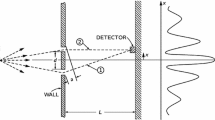The historical background of the 19th century electromagnetic theory is revisited from the standpoint of the opposition between alternative approaches in respect to the problem of interactions. The 19th century electrodynamics became the battle-field of a paramount importance to test existing conceptions of interactions. Hertz’s experiments were designed to bring a solid experimental evidence in favor of one of them. The modern scientific method applied to analyze Hertz’s experimental approach as well as the analysis of his laboratory notes, dairy and private letters show that Hertz’s ‘‘crucial’’ experiments cannot be considered as conclusive at many points as it is generally implied. We found that alternative Helmholtz’s electrodynamics did not contradict any of Hertz’s experimental observations of transverse components as Maxwell’s theory predicted. Moreover, as we now know from recently published Hertz’s dairy and private notes, his first experimental results indicated clearly on infinite rate of propagation. Nevertheless, Hertz’s experiments provided no further explicit information on non-local longitudinal components which were such an essential feature of Helmholtz’s theory. Necessary and sufficient conditions for a decisive choice on the adequate account of electromagnetic interactions are discussed from the position of modern scientific method.
Similar content being viewed by others
References
S. Laplace (1799) Mecanique Celeste Book X Paris 22
T. Van Flandern J.-P. Vigier (2002) Found. Phys. 32 IssueID7 1031–1068
I. Newton, Third Letter to Bentley, from Work of Richard Bentley, III, p. 211.
S. Laplace (1796) Exposition du System du Monde Book IV Paris
P. Graneau N. Graneau (1993) Newton versus Einstein: How Matter Interacts with Matter Carlton Press New York
D. Hoffmann (1998) Heinrich Hertz and the Berlin School of Physics D. Baird R.I.G. Hughes A. Nordmann (Eds) Heinrich Hertz: Classical Physicist, Modern Philosopher Kluwer Academic Dordrecht 1–8
M. Heidelberger (1998) From Helmholtz’s Philosophy of Science to Hertz’s Picture-Theory D. Baird R.I.G. Hughes A. Nordmann (Eds) Heinrich Hertz: Classical Physicist, Modern Philosopher Kluwer Academic Dordrecht 9–24
J. Maxwell, On Faraday’s Line of Force, Scientific Papers, Vol. 1 (1864), p. 160.
M. Hesse (2000) ISIS 46 337–353
H. Hertz (1962) ‘‘On the Fundamental Equations of Electromagnetics for Bodies at Rest’’, in Electric Waves, Collection of Scientific Papers Dover New York 195
M. Hesse (1961) Forces and Fields: The Concept of Action at a Distance in the History of Physics Thomas Nelson and Sons Ltd., London
H. Helmholtz, Wissenschaftliche Abhandlungen, Vol. 1 (Barth, 1882), pp. 611–628.
P. S. Kudryavtzev, History of Physics, Vol. 2 (Moscow University Press, Moscow, 1956), pp. 206–213 (in Russian).
J. Buchwald (1994) The Creation of Scientific Effects: Heinrich Hertz and Electric Waves The University of Chicago Press Chicago
A. E. Woodruff (1968) ISIS 59 300–311
H. Helmholtz, Wissenschaftliche Abhanlugen, Vol. 1 (Barth, 1882), p. 556.
H. Hertz, ‘‘On the Finite Velocity of Propagation of Electromagnetic Actions’’, in Electric Waves, (1888), p. 110.
H. Hertz, ‘‘On very rapid electrical oscillations’’, in Electric Waves, (1887) p. 29–53.
H. Hertz, ‘‘On the finite velocity of propagation of electromagnetic actions’’, in Electric Waves, (1888) p. 108.
H. Hertz, ‘‘On the finite velocity of propogation of electromagnetic action’’, in Electric Waves (1888), p. 121.
J. Cazenobe (1982) Arch. Int. d’Hist. Sci. 32 236–265
M. Doncel (1995) Arch. Hist. Exact Sci. 49 197–270
M. Doncel (1998) On Hertz’s conceptual conversion: from wire waves to air waves D. Baird R.I.G. Hughes A. Nordmann (Eds) Heinrich Hertz: Classical Physicist, Modern Philosopher Kluwer Academic Dordrecht 73–87
J. Z. Buchwald (1993) Electrodynamics in context: object states, laboratory practice and anti-Romanticism D. Caham (Eds) Hermann von Helmholtz and the Foundations of Nineteenth- Century Science University of California Press Berkely 345–368
H. Hertz (1962) Electric Waves, Collection of Scientific Papers Dover New York 15
H. Hertz, ‘‘The forces of electric oscillations, treated according to Maxwell’s theory’’ in Electric Waves, (1889), p. 137.
H. Hertz, ‘‘The forces of electric oscillators, treated according to Maxwell’s theory’’, in Electric waves (1889), pp. 151–152.
W. Panofsky M. Phillips (1962) Classical Electrodynamics and Magnetism EditionNumber2 Addison Wesley P.C. Massachusetts 259–260
H. Hertz, ‘‘The forces of electric oscillations, treated according to Maxwell’s theory’’, in Electric Waves,(1889), p. 149.
H. Hertz, ‘‘On the mechanical action of electric waves in wires’’, in Electric Waves,(1891), p. 187.
M. Heidelberger (1998) From Helmholtz’s philosophy of science to Hertz’s picture-theory D. Baird R. I. G. Hughes A. Nordmann (Eds) Heinrich Hertz: Classical Physicist, Modern Philosopher Kluwer Academic Dordrecht 18
H. Hertz, Electric Waves, Introduction, pp. 18–19.
P. Duhem (1954) The Aim and Structure of Physical Theory Princeton University Press Princeton
P. Duhem (1965) Les Theories Electriques de J. Clerk Maxwell (Paris, 1902); quoted from A. O’Rahilly, Electromagnetic Theory: A Critical Examination of Fundamentals, Vol. 1 Dover New York 161–180
R. P. Feynman, Lectures on Physics: Mainly Electromagnetism and Matter (Addison-Wesley, 1964).
A. Chubykalo R. Smirnov-Rueda (1996) Phys. Rev. E 53 5373–5381
A. Chubykalo R. Smirnov-Rueda (1997) Mod. Phys. Lett. A 12 IssueID1 1–24
A. Einstein (1955) The Meaning of Relativity EditionNumber5 Princeton University Press Princeton
Author information
Authors and Affiliations
Corresponding author
Rights and permissions
About this article
Cite this article
Smirnov-Rueda, R. On Essential Incompleteness of Hertz’s Experiments on Propagation of Electromagnetic Interactions. Found Phys 35, 1–31 (2005). https://doi.org/10.1007/s10701-004-1911-z
Received:
Revised:
Issue Date:
DOI: https://doi.org/10.1007/s10701-004-1911-z




